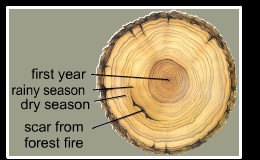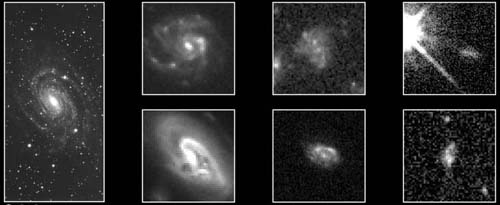Evolution of Stars and Galaxies

Just as ring structure gives us clues about the history of this tree, galaxy structure provides evidence about the evolution of the Universe.
A consequence of the Big Bang theory is the evolution of the universe over time. By examining galaxies with different redshifts, astronomers are able to "look back in time" and obtain data regarding the shape, size, and distribution of galaxies throughout the history of the Universe. The observations made indicate that the trends followed by stars, galaxies and clusters are much different from those we currently see, providing further evidential support for the Big Bang.
Evolution of Galaxies

The shape of galaxies 14 billion years, 9 billion years, 5 billion years, and 2 billion years (from left to right) after the Big Bang.
Surveys of distant, highly redshifted galaxies indicate that in the past galaxies were generally smaller and more irregularly shaped than those of the present age. The images above, courtesy of NASA and WMAP, show a timeline of spiral type galaxies from various points in the Universe's history. Notice how galaxies dating from 2 billion years after the Big Bang are irregular and blob-like, while those from 9 billion years and onward are more regular spirals.
Occasionally the gravitational attraction between galaxies can cause two galaxies to collide. While individual stars rarely slam into each other during such collisions, the tidal forces caused by dramatic shifts in the gravitational field will often reshape and deform the galactic structure. Observations show that primordial galaxies were much more likely to undergo such interactions. Some collisions would result in the merging of small irregular galaxies to form larger spiral or elliptical structures. This cosmic dance is an ongoing process by which galaxies continue to grow and evolve. In fact, in roughly 3 billion years, the Milky Way will collide with its neighbor Andromeda.
 [2.8a] Movie: Galaxial Collisions | Download
[2.8a] Movie: Galaxial Collisions | Download
Evolution of Stars
Changes in stellar structure also provide evidence of an evolving Universe. The first heavy elements were produced by nuclear fusion reactions inside the earliest stars. When these stars reached the end of their life spans some of them exploded as supernovae, scattering traces of heavy elements across the Universe. Subsequent stars formed from this debris and as the cycle of birth and death continued the average ratios of heavy elements inside stars rose with each new generation. Scientists have confirmed these predictions by broad spectrographic surveys.
Compiling the Evidence
To date, the hot Big Bang model is the most successful scientific theory explaining the origins and evolution of the Universe. No alternate theory has been able to satisfactorily account for the range of observed natural phenomena that are intrinsic elements of Big Bang cosmology.
Still, there are lingering questions that must be resolved and theoretical assumptions which will be empirically tested for the first time in the coming decades. Cosmology remains an open field, yet given the immense body of evidence in its support, scientists are confident that the Big Bang model will continue to provide the framework upon which new discoveries will build.
 [2.8b] Cosmic Conundrums: Stellar Evolution
[2.8b] Cosmic Conundrums: Stellar Evolution


